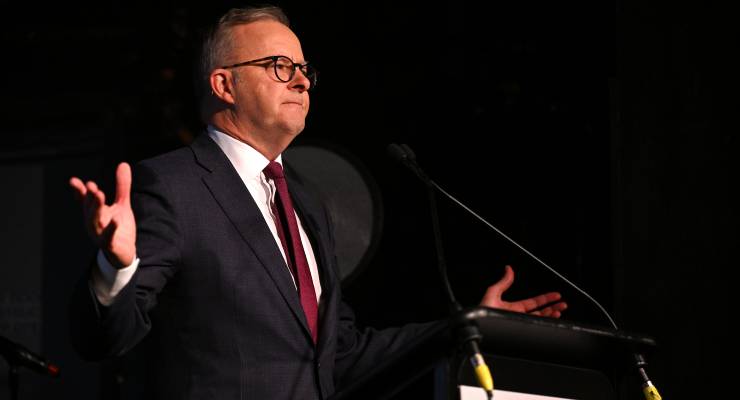
The Espy, St Kilda’s grand old rock pub, has long been a favourite venue for the Labor Party, so it was no surprise that Prime Minister Anthony Albanese and Arts Minister Tony Burke chose to launch the government’s cultural policy there.
Labor is rightly proud of its legacy of cultural policy. Gough Whitlam created the Australia Council, and Paul Keating gave us artistic fellowships and a nationwide triple j. Even if Julia Gillard’s administration was not particularly arts friendly, she did give us Australia’s last cultural policy, Creative Australia, in 2013.
So yesterday’s announcement was a big deal, with part-time DJ Albo warming up the faithful and introducing Burke, then sticking around to pose for a selfie with Missy Higgins.
What does the policy involve?
Entitled Revive, the new cultural policy is an overdue repair job aimed at a decade of Coalition neglect. It also doubles as a down payment by a Labor government eager to signal its commitment to a cultural sector seen as a core part of its electoral base.
Like 2013’s Creative Australia policy, Revive is rhetorically based on five “pillars”, and begins with an unreserved commitment to First Nations arts and culture. But unlike Creative Australia, Revive has much more funding attached. It also sets up a policy architecture for culture, completely remaking the Australia Council, and setting up policy agencies for music, literature, First Nations culture and cultural workplace regulation.
There are big wins for the literature and contemporary music sectors, reflecting the poor treatment both received under the old Australia Council. Federal funding for writing has declined to just a few million dollars a year, and contemporary music was also shunted as a commercial enterprise unworthy of government support.
Revive will set up funding structures entitled Music Australia and Writing Australia, with new money for each. Authors will also benefit from an extended public lending right royalty to e-books (almost unbelievably, the current scheme applies only to print publications).
Out with the old
Revive contains implied criticism of the Australia Council, subsuming the arts funding agency created by Whitlam into a larger entity called Creative Australia. Exactly what the “machinery of government” arrangements will be are not spelt out, but it is in some ways a return to the original structure of the council, with a series of artform bodies for music, writing and First Nations culture set up underneath the overarching authority of the federal funding agency. It will be interesting to see whether the Australia Council Act requires amending.
Cultural policy is nothing if not symbolic, but this policy will also be judged by the dollar figures attached to it. And to a surprising degree, Burke and Albanese have delivered. They have committed about $280 million to cultural funding, most of it new money, and most targeted at areas of pressing need.
There is further funding promised down the track — the ABC will enjoy a boost, and there are strong hints national cultural institutions such as the National Library and National Gallery will be looked after in the next budget.
In the context of the commonwealth’s annual cultural spend of about $800 million (not counting the ABC and SBS), $280 million over the next few years is significant, if not transformative. After a decade of crippling austerity, it will be warmly welcomed.
What’s to come
Some further big decisions were hinted at but not detailed. For instance, the government has committed to legislating local content quotas for streaming services such as Netflix and Disney+. Burke said the government would immediately begin consulting, with a timeline for new legislation to be tabled later this year. However, no quota figure was specified, nor any mechanism for how local content targets would be achieved. You can bet the big media lobbyists will be busy.
One of the more intriguing aspects of the policy is a regulatory body to be called the Centre for Arts and Entertainment Workplaces, which the government said has been specifically set up in response to last year’s damning Raising Their Voices report on sexual harassment in the music industry.
The centre will “provide advice on issues of pay, safety and welfare in the arts and entertainment sector, refer matters to the relevant authorities and develop codes of conduct and resources for the sector”. If the new body has teeth, it will be busy. Cultural workplaces are notorious for their abusive behaviour.
Artist payments
If there is a criticism that can be made of Revive, it may be about how many individual artists will benefit. Pillar three of the policy is entitled “Centrality of the Artist” and Burke thrilled his audience when calling them “essential workers”. The policy does commit to a review of (largely ignored) modern awards for artists and performers, and to paying minimum rates for artists performing at government events.
But Revive is relatively quiet about improved support structures for solo practitioners, such as grants to make work or artistic fellowships (although there are some interesting references to “works of scale”). There are some dots to connect here with Burke’s other portfolio of employment and workplace relations, particularly on the cultural part of the “gig economy”.
Caveats aside, the cultural sector will be very pleased. It’s not everything that everybody asked for, but there’s something for nearly everyone. After the wilderness years of Tony Abbott, Malcolm Turnbull and Scott Morrison, this is the best day for Australian arts funding in a decade.
Was this a good move in these tight economic times? Let us know by writing to letters@crikey.com.au. Please include your full name to be considered for publication. We reserve the right to edit for length and clarity.








There seems to be little news here for performing arts workers (apart from live musicians) – actors, dancers and other live performers, playwrights, directors, stage/lighting/sound designers, technicians and venue staff. This is disappointing given that the performing arts sector was arguably the most severely impacted by the pandemic, which largely shut the live performance industry down for the best part of two years, putting thousands out of work, many of whom were not supported by Jobkeeper as freelance workers. In addition to more long-term funding for individual live performance artists (not just residences and fellowships but annual funding for individuals as well as companies), there also needs to be more long-term funding for ensembles of performers and creatives, and in general a greater recognition that live performance is an inherently collaborative art form, not just an individual one, and that it requires continuity of work, not just piecemeal gigs, for performers to maintain their skills and sustain themselves financially and emotionally.
a lot of our grass roots content producers would benefit from a rise in the Orwellian Newstart stipend coupled with a decrease in the constant harassment of the robo debt affiliate “jobs providers” network…or are we still avagogeddago..